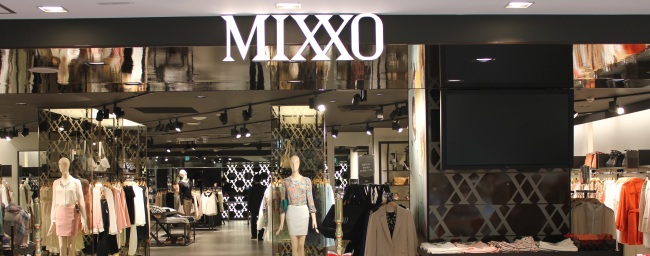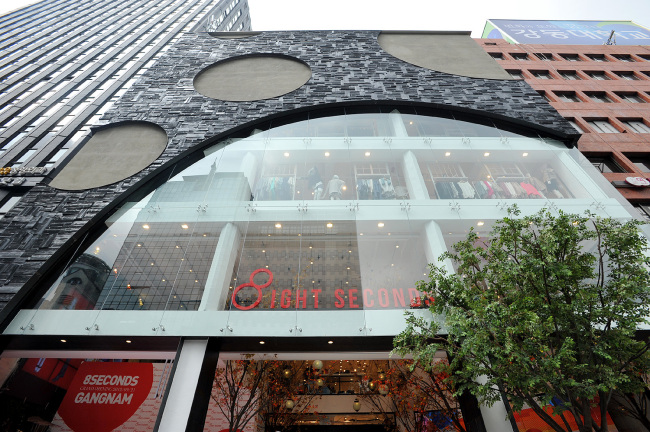Korean fast fashion brands are expanding overseas, hoping that tailoring items for Asian consumers will be a winning strategy.
Korean fashion retailer E.Land Group has taken an aggressive lead, opening Japanese and Chinese stores of its women’s apparel brand Mixxo in March and May, respectively.
In China, Mixxo has stores in Super Brand Mall in Shanghai, a prime retail spot, directly competing with fast fashion brands such as Spain’s Zara, Sweden’s H&M and Japan’s Uniqlo. Riding on the back of Korean pop culture’s popularity in China, the label aims to expand its presence there with more store openings in the works.
Korean fashion retailer E.Land Group has taken an aggressive lead, opening Japanese and Chinese stores of its women’s apparel brand Mixxo in March and May, respectively.
In China, Mixxo has stores in Super Brand Mall in Shanghai, a prime retail spot, directly competing with fast fashion brands such as Spain’s Zara, Sweden’s H&M and Japan’s Uniqlo. Riding on the back of Korean pop culture’s popularity in China, the label aims to expand its presence there with more store openings in the works.

“Asian customers love Mixxo because of its reasonable price, clothes that come in a variety of colors and that fit the Asian body,” said Chung Soo-jung, director of Global Mixxo Business Unit of E.Land Group.
The average prices are set around 299 yuan ($48) to 499 yuan in China, and 3,990 yen ($40) and to 5,990 yen in Japan, slightly higher than the average Korean price of 39,900 won ($36) to 59,900 won.
“From the beginning, Mixxo was developed to meet the different needs of Asian women who often have to get clothes they bought at Western SPA brands altered to fit their bodies.
“The brand, which launched in 2010 in Korea, became popular with its inexpensive pricing that enables customers to buy tops, bottoms and even accessories all at once,” said Chung.
SPA stands for specialty retailer of private label apparel, more commonly known as fast fashion.
The brand which set women in their early 20s and mid-30s as its main target customers, now aims to appeal to younger Asian women, using Korean girl group After School as models.
Another fashion retailer, Samsung Cheil Industries, is getting ready to join the global fast fashion race with its first overseas 8 Seconds store in China scheduled to open next year.

From the initial brand planning stage, Korea’s giant fashion company had Chinese consumers in mind.
“Starting with the name, we picked the number 8, the favorite number of the Chinese. The color of the logo, red, is the color of fortune in China,” said Kwon Eun-ju, assistant manager of the communication team at Samsung Cheil Industries Inc.
In anticipation of the launch in the Chinese market next year, the company has started to raise brand awareness among foreign customers in Korea. Since last May, the 8 Seconds brand stores have been playing audio announcements in Chinese, Japanese and English at major stores in Seoul.
The Garosu-gil store has become one of the must-see trendy spots in Seoul for Japanese tourists.
“Japanese customers make up half of the daily sales at the Garosu-gil store on our best-selling days,” said Ahn Seon-jin, director of 8 Seconds.
The brand aims to gain ground in the global fashion competition by focusing on specific needs that the better-known global brands miss. The niche the company is targeting lies between Japanese casual wear brand Uniqlo and trend-conscious Zara and H&M.
“We found that more than 60 percent of customers at Uniqlo are men who like basic casual items and more than 70 percent of customers at Zara and H&M are women who prefer stylish and trendy designs. The brand has set different approaches specific to different age and gender groups,” said a brand analysis report prepared by the company before its launch in Korea last year.
The brand has positioned itself as a trendy casual wear brand offering products ranging from basic casual items to stylish items for trend-conscious consumers.
“In the economic slowdown, the fashion market is becoming polarized ― consumers shop either at high-end luxury brands or inexpensive SPA brands. Fashion brands will focus on adding luxury appeal to their established brands or continue to expand fast fashion brands,” said Kwon.
By Lee Woo-young (wylee@heraldcorp.com)


















